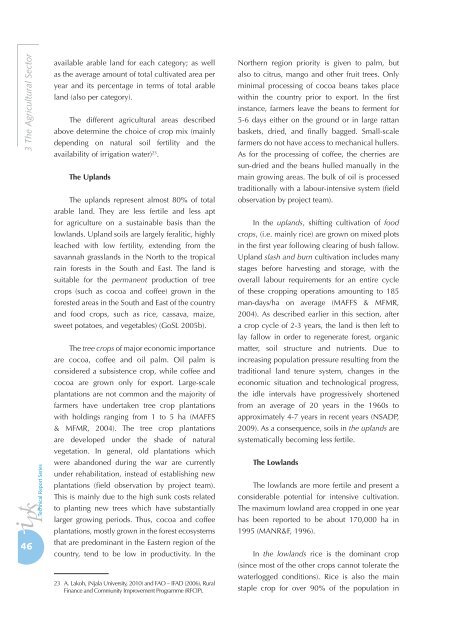SIERRA LEONE maq 4ª.indd - agrilife - Europa
SIERRA LEONE maq 4ª.indd - agrilife - Europa
SIERRA LEONE maq 4ª.indd - agrilife - Europa
Create successful ePaper yourself
Turn your PDF publications into a flip-book with our unique Google optimized e-Paper software.
3 The Agricultural Sector<br />
46<br />
available arable land for each category; as well<br />
as the average amount of total cultivated area per<br />
year and its percentage in terms of total arable<br />
land (also per category).<br />
The different agricultural areas described<br />
above determine the choice of crop mix (mainly<br />
depending on natural soil fertility and the<br />
availability of irrigation water) 23 .<br />
The Uplands<br />
The uplands represent almost 80% of total<br />
arable land. They are less fertile and less apt<br />
for agriculture on a sustainable basis than the<br />
lowlands. Upland soils are largely feralitic, highly<br />
leached with low fertility, extending from the<br />
savannah grasslands in the North to the tropical<br />
rain forests in the South and East. The land is<br />
suitable for the permanent production of tree<br />
crops (such as cocoa and coffee) grown in the<br />
forested areas in the South and East of the country<br />
and food crops, such as rice, cassava, maize,<br />
sweet potatoes, and vegetables) (GoSL 2005b).<br />
The tree crops of major economic importance<br />
are cocoa, coffee and oil palm. Oil palm is<br />
considered a subsistence crop, while coffee and<br />
cocoa are grown only for export. Large-scale<br />
plantations are not common and the majority of<br />
farmers have undertaken tree crop plantations<br />
with holdings ranging from 1 to 5 ha (MAFFS<br />
& MFMR, 2004). The tree crop plantations<br />
are developed under the shade of natural<br />
vegetation. In general, old plantations which<br />
were abandoned during the war are currently<br />
under rehabilitation, instead of establishing new<br />
plantations (field observation by project team).<br />
This is mainly due to the high sunk costs related<br />
to planting new trees which have substantially<br />
larger growing periods. Thus, cocoa and coffee<br />
plantations, mostly grown in the forest ecosystems<br />
that are predominant in the Eastern region of the<br />
country, tend to be low in productivity. In the<br />
23 A. Lakoh, (Njala University, 2010) and FAO – IFAD (2006), Rural<br />
Finance and Community Improvement Programme (RFCIP).<br />
Northern region priority is given to palm, but<br />
also to citrus, mango and other fruit trees. Only<br />
minimal processing of cocoa beans takes place<br />
within the country prior to export. In the first<br />
instance, farmers leave the beans to ferment for<br />
5-6 days either on the ground or in large rattan<br />
baskets, dried, and finally bagged. Small-scale<br />
farmers do not have access to mechanical hullers.<br />
As for the processing of coffee, the cherries are<br />
sun-dried and the beans hulled manually in the<br />
main growing areas. The bulk of oil is processed<br />
traditionally with a labour-intensive system (field<br />
observation by project team).<br />
In the uplands, shifting cultivation of food<br />
crops, (i.e. mainly rice) are grown on mixed plots<br />
in the first year following clearing of bush fallow.<br />
Upland slash and burn cultivation includes many<br />
stages before harvesting and storage, with the<br />
overall labour requirements for an entire cycle<br />
of these cropping operations amounting to 185<br />
man-days/ha on average (MAFFS & MFMR,<br />
2004). As described earlier in this section, after<br />
a crop cycle of 2-3 years, the land is then left to<br />
lay fallow in order to regenerate forest, organic<br />
matter, soil structure and nutrients. Due to<br />
increasing population pressure resulting from the<br />
traditional land tenure system, changes in the<br />
economic situation and technological progress,<br />
the idle intervals have progressively shortened<br />
from an average of 20 years in the 1960s to<br />
approximately 4-7 years in recent years (NSADP,<br />
2009). As a consequence, soils in the uplands are<br />
systematically becoming less fertile.<br />
The Lowlands<br />
The lowlands are more fertile and present a<br />
considerable potential for intensive cultivation.<br />
The maximum lowland area cropped in one year<br />
has been reported to be about 170,000 ha in<br />
1995 (MANR&F, 1996).<br />
In the lowlands rice is the dominant crop<br />
(since most of the other crops cannot tolerate the<br />
waterlogged conditions). Rice is also the main<br />
staple crop for over 90% of the population in
















